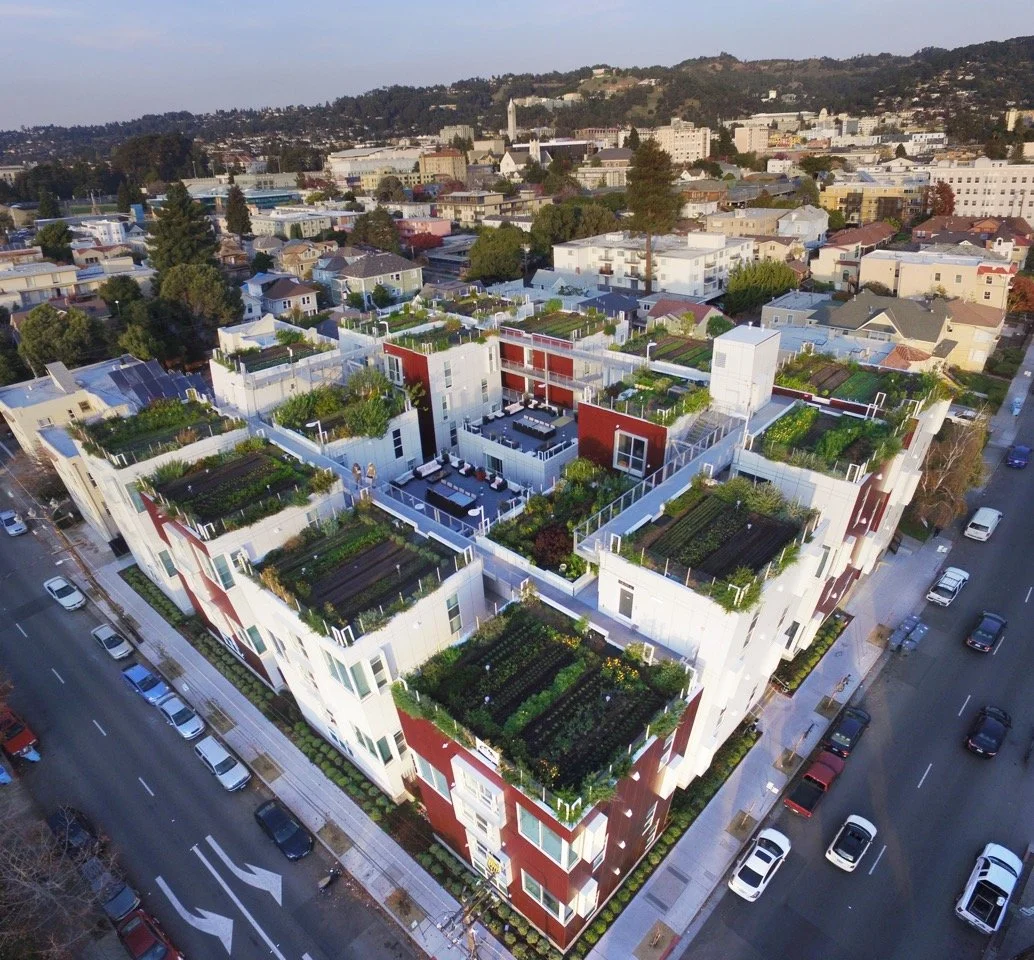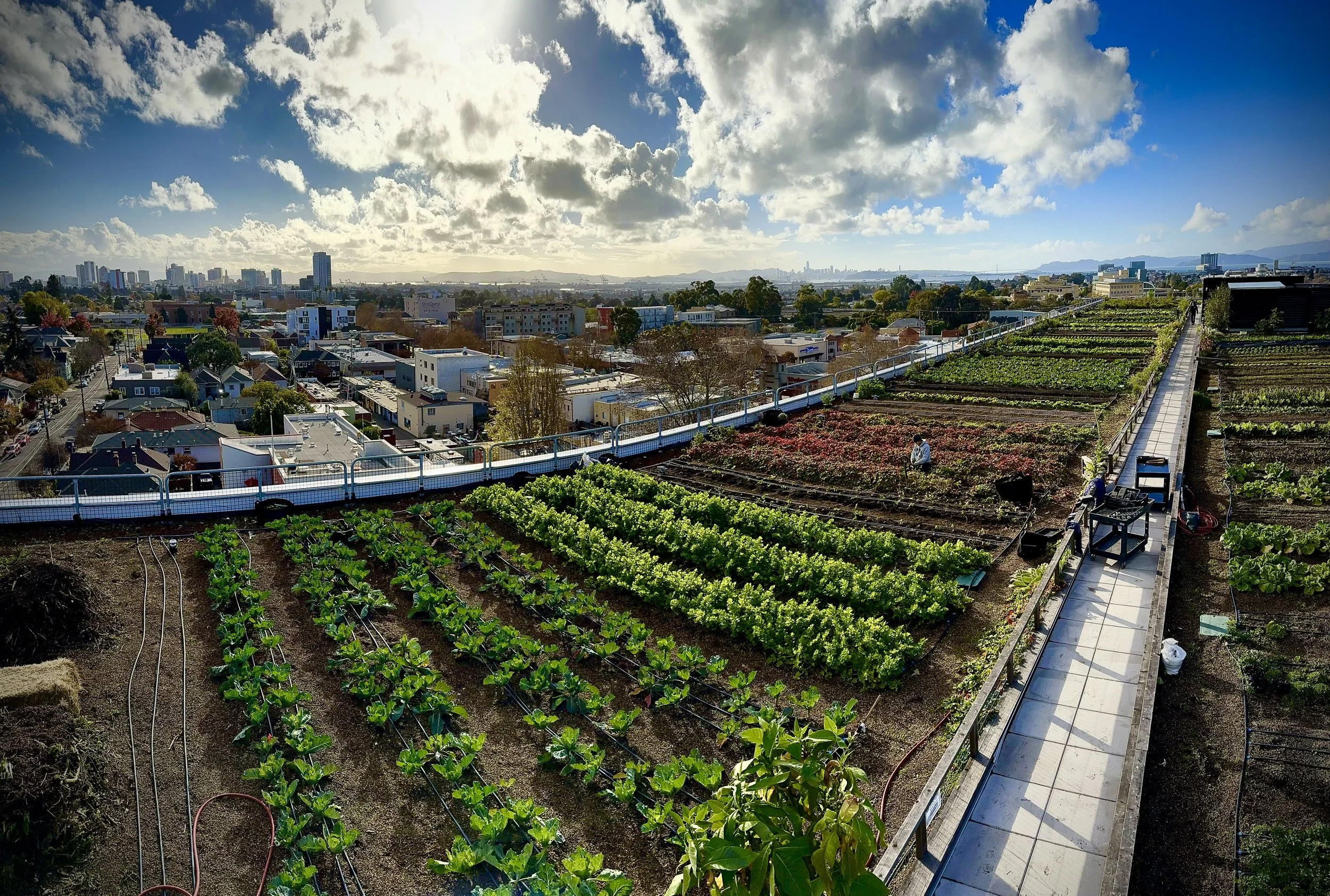Farm the Roof: Building Rooftop Farms in the San Francisco Bay Area
Advertisement
Rooftop Medicine Farm - 1 acre farm In Oakland. Victoria Chaves - DMC Rooftop Manager - Finishes prepping bed at Rooftop Medicine Farm. Photo: Benjamin Fahrer
Introduction
I was never a city person. I spent most of my adult life away from the busy urban life as a land steward, farmer and builder in the coastal California hills. Yet life always has another plan brewing for us if we lean into it.
Berkeley, CA 2013 - The Developer, RAD Urban, was curious if they could create a rooftop farm on their student housing project. The sustainability consultancy team stated that if you want to farm the roof you would need a farmer. At that time I was consulting, designing and building out farm projects and had 15 years or organic production experience. My Aries nature was challenged by the possibility. I gave a great presentation and I was hired to design it so I leaned in.
I met with Ben Flanner co-founder of Brooklyn Grange, and I studied rooftop growing media and applied my knowledge of soil health to engineer a custom mix to meet the guidelines and to max out the organic matter. After 2 years and 8 different mixes we produced one of the best growing medias on the market today. The inclusion of a granular material, no fines, and BioChar from Black Owl was the missing piece of that puzzle.
I customized the overburden layers and included a drain wick layer over the American HydroTech HDR_40 drainboard to serve as a reservoir for the capillary roots to wick from. I was asked to install the design - so then I became a licensed contractor and started Top Leaf Farms. Since then I have installed the 12,000 square foot farm that was spread out over 16 different roofs. This was the whole system: soil to irrigation, harvest area to cooler, perennial plants to compost tea brewer, all the components for a small farm to function. The design and installation ended up coming in at $32 per square foot and the additional start up costs to operate the farm were $10,000 US.
Advertisement
Garden Village - 16 growing platforms on top of UC Berkeley Student Housing from above. Photo: Benjamin Fahrer
The Garden Village project won the 2017 AIA Innovation Award and I operated the roof for 2 and a half years with one other crew member at half time. We supplied eight local high end restaurants with hyper local ultra fresh produce. Hedgerows hung over the building providing beneficial insect habitat and operations broke even because the high cost of living in the San Francisco Bay Area. This project was also following an standard model of farming hustle that was fun, hard and exhausting work. During this time I continued to design and consult on multiple urban projects in the bay area - the design build work subsidizing the farming. Over the next 10 years I have worked with some of the best architectural design firms and teams in the San Francisco Bay Area on 8 different projects and we have designed and installed over 65,000 sf of rooftop farming. Currently, Garden village is now operated by Bluma Farms, which offers certified organic flowers.
The largest of these is the Rooftop Medicine Farm located in the Temescal district of North Oakland. This one acre rooftop design started in 2014 and we finished the installation in 2021. The farm sits on top of a mixed use residential building of modular construction with 226 units and is 6 stories tall. Many massive projects experience budget creep and by the time they get to the roof the team is looking hard for cost cutting solutions. I suggested that instead of going with a sub contractor they hire me as a consultant and I work with their team to install it. The original bids for the roof were between $30-$40 per square foot. We ended up installing it for only $18 per square foot.
Many developers are interested in living roofs that can be used as farms yet the inevitable questions come up of who is going to operate them and what is the business model. The operations of the Bay Area farms became a question due to the COVID-19 shutdown. As a result, I helped co-found a non-profit The Deep Medicine Circle to address food and nutritional inequalities. We created a ‘Farming Is Medicine Initiative’ that positioned farmers as health stewards on the premise that taking care of the soil is also taking care of people. I became the director of Agroecology for DMC and would then oversee and help operate the rooftop farm along with a sister farm a hour south of San Francisco in San Gregorio. We hired young BIPOC farmers and created positions of leadership for them to learn and grow into. We wanted to model of an urban to rural corridor and translate the practices of scale of each farm. I designed and helped build out the coast farm, a 38 acre site with 5 acres of production. Both farms are certified organic and give food to local food hubs to help establish basic universal nutrition for the community. The rooftop farm produces and distributes over 20,000 pounds of food per year. The start-up costs to build out the supportive infrastructure of the farm, irrigation, walkin cooler, wash pack, along with all the tools and equipment were just over $35,000. Thus the whole farm cost just over $700,000 for 40,120 square feet.
Advertisement
The Oakland rooftop farm is in its 3rd year of production and is now starting to mature with 3,000 square feet of native living roof and an edge of native hedgerows. The 158 growing beds are 33 feet long, 32” wide and grow 2-4 crops each per year, mainly leafy greens, root crops and surprisingly well have been watermelons. We practice a no-till operation with a living membrane that holds the structure of a rich Mycelium mat, that acts as a super nutrient highway. The fertility of the roof is becoming more of a closed loop as we brew teas from the compost we make and inject it into the irrigation system to feed the soil which then feeds the plants. The cover cropping on the roof has been one of the most beneficial practices along with the establishment of living mulch pathways comprising New Zealand white clover. By covering the pathways we are covering the whole roof with plants which helps retain moisture, prevents wind impact on the soil, fixes nitrogen and through the mowing pumps organic matter into the soil, sequestering carbon.
The living ecology of the 1 acre Rooftop Medicine Farm is Operated by the Deep Medicine Circle and sits atop a mixed use modular construction in North Oakland, Ca. Photo: Benjamin Fahrer
Conclusion
Green Roofs are instrumental to implementing climate solutions in cities and urban agriculture is vital for localizing elements of our food system. Green roofs are often over designed, over engineered and more complicated than they need to be based on architects and contractors being unfamiliar with the system and unwilling to approach the project with a beginner's mind. This results in living roofs and rooftop farms being cost prohibitive and valued engineered out of far too many projects. The system and components can be simple and functional and if we work with nature a rooftop farm provides a huge value to urban development. When we turn living roof projects into farm systems we can maximize the potential that goes into these resource heavy systems. For urban dwellers we often leave the city and go to where it is “wild” to seek inspiration and rejuvenate. If we can rewild our urban centers by integrating the natural systems within ecological agriculture then I believe our cities will be much more inspiring to live in and regenerative for the soul. We just need to lean in.
Advertisement
Benjamin Fahrer is the co-owner and principle of Top leaf Farms- a Californian based design build contractor focussed on integrated rooftop farming systems. He has over 25 years of organic farming and design experience with a deep commitment to restoring mutual beneficial relationships.







